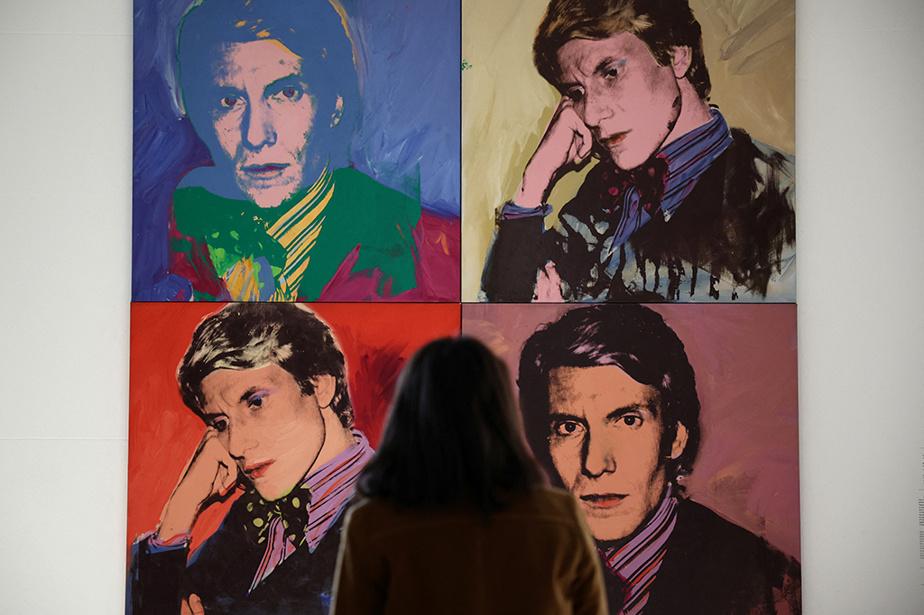Yves Saint Laurent and contemporary art: five striking dialogues
"Every man is forced to survive to have, as Nietzsche says, aesthetic ghosts.(...) I am completely eclectic, "assured Yves Saint Laurent.
Here are the five most striking confrontations between the creations of the Grand Couturier and the works of contemporary art at the Center Pompidou, on the occasion of the celebration of the 60th anniversary of the Maison Saint Laurent which opens Saturday simultaneously in six museums in Paris::
.Mondrian dress
"Revolutionary", many times copied all over the world and inspiring other works of art, it is the Mondrian dress, drawn in 1965 by Yves Saint Laurent, which popularized the Dutch painter, one of the pioneers of the'abstraction.
"It is almost at the time that fashion changes its status and begins to become an art in itself," said Aurélie Samuel, director of the collections of the Yves Saint Laurent Museum in Paris.
It all starts with a book on Piet Mondrian, which was not well known at the time and that his mother offered to Saint Laurent.
"He has a kind of revelation, will draw the first Mondrian dress and all his creation this year will be very inspired by this geometry and a form of abstraction", which the press will call "totally revolutionary".
Perhaps Yves Saint Laurent keeps in mind this reflection of the painter, which he will apply his life to haute couture: "Only pure relationships, pure constructive elements, can lead to pure beauty"".

The Mondrian collection provides the fashion house an unprecedented success.The first retrospective of Mondrian's work, died in 1944, took place in 1969 at the Musée de l'Orangerie in Paris, four years after the Yves Saint Laurent parade.
.Vasarely patterns
"You will find it difficult to believe that the dresses were made in the 1970s," says Madison Cox, president of the Pierre Bergé-Saint Laurent Foundation.
Long or mid-length, clean cut, geometric patterns: the dresses exhibited at the Pompidou center against Victor Vasarely's panels "are in fashion showcase today", underlines Madison Cox.
Victor Vasarely, a Franco-Hungarian plastic artist, distinguished himself during his lifetime by creating a new trend: optical art.
.Green fox or assumed kitsch
How to obtain your fbi file http: // bit.ly/DVP5(via @wikihow)
— Chris Guillebeau Tue Apr 14 01:13:01 +0000 2009
In 1964, Martial Raysse inaugurated the series "Made in Japan", which diverts the icons from art history, including "La Grande Odalisqque" of Ingres which was photographed, cropped, painted by airbrush then set with cross -collateralsand a plastic fly.
In 1971, Yves Saint Laurent presented the collection inspired by fashion under the occupation.The same approach of appropriation and desecration the anime.Central part of the collection: a green fox coat.
"He has the taste of assumed kitsch, an unusual green shade in fashion and in painting too.He takes up the fashion codes under occupation: short mantle, large shoulders, furs ", lists Marie Sarré, from the Modern Collections Service of the Center Pompidou.
"This will cause the ire of the press and the criticisms.On the other hand, it will be a wide success with the public and launch retro fashion ".
.Naked pop
"How could I have resisted Pop Art, which was the expression of my youth?" Asked the couturier later.
In 1966, he produced in jersey, the "only modern material" according to him, dresses inspired by the "Great American Nudes" of the American Pop painter Tom Wesselmann.
It is also the latter's work that Gary Hume, a member of the Young British Artists, is regularly inspired by.
Gary Hume isolates anatomical details, such as the arm of a cheerle.
.Kinetic art
An orange dress with full skirt with roundabouts is installed in the middle of the paintings of Sonia Delauney, French artist of Ukrainian origin.
Saint Laurent is interested in the work of the couple Sonia and Robert Delauney: he has in their studio artists' books, who especially worked together on the search for pure color and the movement of simultaneous colors.
"The scrolls, the roundabouts, are inspired by the kinetic paintings of the Delauney", underlines Marie Sarré, recalling that Sonia Delauney had herself made dresses "simultaneous to put on the body of women the rhythm and the color".








